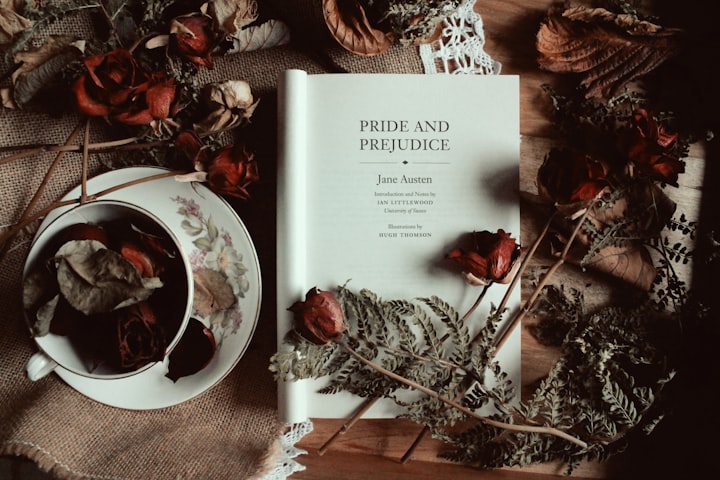Austenland
Would Jane Austen Approve?

Introduction
In Ellen Belton’s essay “Reimagining Jane Austen: 1940 and 1995 film versions of Pride and Prejudice” she shares that
Ever since the earliest narrative films, the novel has been a gold mine for the film industry, and ever since Sergei Eisenstein's discourse on the influence of Charles Dickens on D.W. Griffith, film critics have been fascinated by the similarities between novelistic and cinematic forms (Belton 175).
Her analysis of the 1995 film adaptation was helpful in understanding key elements of Austen’s novels and how those elements of characterization were depicted in the 2013 film adaptation, Austenland.
Summary
Obsessed with the BBC adaptation of Pride and Prejudice (1995), Jane Hayes travels to Austenland, a Jane Austen theme park in England, in search of her perfect gentleman. This romantic comedy highlights Jane’s “immersive” experience at the Darcy place, playing the part of an orphaned Miss Jane Erstwhile. The pairings of couples leave Jane out of the romance except for the forbidden fling with Martin, the groundskeeper. When Captain East finally arrives, Jane becomes a part of the group until Lady Amelia Heartwright shares with her that she and Captain East are engaged. This leaves Jane with Mr. Nobley, who she already despises because of his manners towards her and the constant bickering between them.
Formal Analysis
What is most interesting is the character development in Austenland. Jane Hayes/Erstwhile, Henry Nobley, and Mrs. Wattlesbrook embody the characteristics of Elizabeth Bennet, Mr. Darcy, and Lady Catherine. There are particular scenes in Austenland where we see the similarities between the novel and the 1995 and 2013 adaptations. Not only are the scenes similar in this adaptation, but the progress of the relationship between Jane and Henry is similar in that it
is charted through a movement from sidelong glances to direct contemplation to mutual admiration (Belton 190).
The tension between Jane and Henry is introduced almost immediately when Jane asks him about dancing and he states that he does not enjoy dancing and to engage in social intercourse is only to seem courteous. This is similar to Mr. Darcy, who prefers to observe rather than dance. However, there are characteristics of other Austen figures that find their way into the film.
Jane Hayes/Erstwhile is similar to Elizabeth Bennet in that she is optimistic, loves to travel, and enjoys a good laugh. Like Elizabeth, Jane has to feel pain or reality so that she can change and grow. For Jane Hayes, this occurs when she realizes that she has confused fantasy for reality, unable to discern between acting and true feelings. This realization occurs at the Ball when Henry Nobley attempts to share his true feelings for Jane. Like Elizabeth, who rejects Mr. Darcy’s confession:
You must allow me to tell you how ardently I admire and love you,
Jane flees the ball. The character, Miss Erstwhile also takes on the persona of other Austen characters. She walks in the rain by herself like Marianne Dashwood in Sense and Sensibility and is rescued by Mr. Nobley. We have seen that rescue in many forms as well. The sketch of Martin and Mr. Nobley duking it out is another familiar image found in Austen’s novels. After Mrs. Wattlesbrook explains the scenario and circumstances for Jane’s immersive experience, Jane leaves threatening to have the place shut down. In an attempt to smooth things over, Mrs. Wattlesbrook sends Martin after her. The airport scene includes an actual physical altercation between Henry and Martin (the sketch comes to life). Jane makes a declaration that she is done and arriving home she declutters her apartment, removing all vestiges of Mr. Darcy. When Henry shows up at her apartment and confesses to Jane, I immediately thought of Mr. Elton from Emma and his protest in the proposed match with Harriet Smith. He made a decision based on what he thought were the facts. Jane made decisions on what she thought were the facts when she left England. Thankfully, she didn’t get married before Henry could clear things up.
Mr. Nobley embodies Mr. Darcy who constantly observes rather than engages. He disguises his observations by always having a book in his hands when seated in the drawing-room. Mr. Nobley is the nephew of Mrs. Wattlesbrook, mirroring the coupling of Mr. Darcy and Lady Catherine. Yet, he also takes on some of the traits of Mr. Knightly from Emma, especially when trying to protect Jane from Martin. He tries to correct her behavior, like walking alone in the dark. At the end of the film when Henry follows Jane back to the states, he reveals that he is not an actor. He is a history professor and he was doing a favor for his aunt. His confession to Jane is that she was his fantasy. This revelation is much like the revelation made about Emma’s friend, Harriet:
Harriet’s parentage became known. She proved to be the daughter of a tradesman, rich enough to afford her the comfortable maintenance which had ever been hers, and decent enough to have always wished for concealment. Such was the blood of gentility which Emma had formerly been so ready to vouch for!
Mrs. Wattlesbrook is a great stand-in for Lady Catherine de Bourgh, who is a direct, self-reliant, self-confident, and protective aunt and guardian. She is incredibly controlling. And in the novel, Pride and Prejudice, she even has to control Mr. Collins’ closets. Mrs. Wattlesbrooks has particular rules that almost had Jane removed from the resort (a mobile phone in her belongings). Mrs. Wattlesbrook looks down on Jane because she does not have money like Miss Elizabeth Charming and Lady Amelia Heartwright. She makes every effort to make Jane feel uncomfortable. However, when Jane takes things into her own hands the control begins to shift. We soon discover that even through all the control, Mrs. Wattlesbrooks is unable to control her husband who can’t keep his hands off of the female guests. In the end, she can’t control love. Henry and Jane fall in love.
In the novel Lady Catherine’s opposition to Elizabeth and Darcy’s marriage is unrelenting (Belton 182),
however, after Elizabeth and Darcy were wed, Lady Catherine
condescended to wait on them at Pemberley.
Similarly, Mr. and Mrs. Wattlesbrooks found themselves waiting on many.
Like the BBC/A&E adaptations, the long-awaited kiss between Henry and Jane ends the scene in Jane’s apartment. The film then cuts to a carnival-type theme park in Austenland where we see the previous couples in their true form. Belton’s thoughts on the novel hold true to the film:
Austen’s final chapter strikes a delicate balance between the claims of kinship and the importance of personal fulfillment through romantic relationships (Belton 185).
The endings of both film adaptations do not adhere to the novel - and frankly, audiences would have found the ending from the novel boring. The kissing scenes show society's view on relationships between men and women and what it means to be romantically loved by another. In addition to the altered endings, these film adaptations varied dialogue and sequence of events.
All the turmoil of heartache and disappointment have been nicely healed into a reconciliation for the couples, sort of. Like Shakespeare's plays: A Midsummer Night's Dream and Twelfth Night, in which the couples are all mixed up and need some untangling. The brides are "perfectly matched", as Emma would say, at the end of this adaptation. Jane has Henry, Amelia is with her very old man, and Elizabeth is with her possibly gay companion. Very funny.
References
Austen, Jane. “Pride and Prejudice.” The Complete Works of Jane Austen, In One Volume, Independently Published, 2020, pp. 127–246.
Belton, Ellen. “Reimagining Jane Austen: the 1940 and 1995 Film Versions of Pride and Prejudice.” Jane Austen on Screen, edited by Gina Macdonald and Andrew Macdonald, Cambridge University Press, Cambridge, UK, 2008, pp. 175–196.
Hess, Jerusha, director. Austenland. 2013,
About the Creator
Rebecca A Hyde Gonzales
I started writing when I was about eight years old. I love to read and I also love to create. As a writer and an artist, I want to share the things that I have learned and experienced. Genres: Fiction, non-fiction, poetry, and history.






Comments
There are no comments for this story
Be the first to respond and start the conversation.